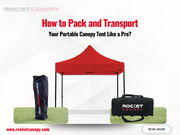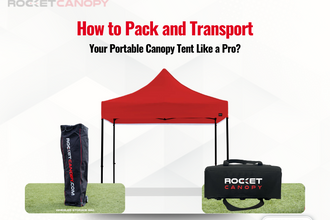
How to Pack and Transport Your Portable Canopy Tent Like a Pro?
A portable canopy tent is a staple ingredient for successful outdoor events, from trade shows and festivals to markets and sports meets. While it’s designed for convenience and quick setup, many businesses overlook one crucial part of the process: packing and transporting it properly.
Unlike other tent brands, Rocket Canopy portable canopy tents have a non-detachable canopy that stays fixed to the frame. This feature makes setup faster, but it also means extra care is needed during packing and transporting to prevent fabric damage or frame warping.
In this guide, we’ll walk through best practices to pack and transport your tent like a pro, recommend essential storage bags, and help you get more life out of your tent with less hassle.
Table of Contents
Why Transporting Your Canopy Tent Correctly Matters?
Improper packing and careless handling are common reasons canopy tents wear out prematurely. Damage to the frame, rips in the fabric, or lost accessories can all result from:
- Tossing it into a vehicle without support
- Folding it roughly or with debris on the canopy
- Skipping protective storage bags
- Not separating accessories like sidewalls
Treating your portable canopy tent like professional gear, not just a quick tool, can make a huge difference in longevity and reliability.
Steps to Packing and Transporting the Portable Canopy Tent
Step 1: Clean and Dry the Tent Before Packing

Because the canopy is attached to the tent frame, it folds along with the structure. That means whatever’s on the fabric gets folded in too. Thus, always clean the tent before folding:
- Wipe off dirt, dust, or debris with a soft cloth or broom.
- Let the canopy dry thoroughly if it’s been used in the rain or dew.
- Avoid folding when the fabric is damp to prevent mould, odours, and stains.
Step 2: Collapse the Frame with Care

Fold the entire unit as one piece. And to do that properly, follow these steps:
- Make sure all legs are unlocked and lowered to their shortest height.
- Ask a second person to help (if needed) to contract from opposite corners.
- Gently push inward on diagonal corners to collapse the frame.
- Take care not to drag the canopy over rough ground while folding.
Tip: Make sure to be patient while handling, as sudden pressure can damage trusses or create unnecessary strain on the fabric.
Step 3: Secure the Collapsed Tent

Once the tent is fully collapsed:Once the tent is fully collapsed:
- Use built-in straps (if available) or secure with external Velcro or webbing straps.
- Ensure the fabric is neatly tucked in and not caught between folding bars.
- Don’t over-tighten if the fabric is thick; just secure enough to keep it compact.
This prevents the frame from springing open and protects the canopy top from being pinched or torn.
Step 4: Organize and Store Accessories Separately

A tent setup requires more than just a tent frame. It requires accessories like sidewalls, weights, etc., too. A common mistake is jamming all the accessories into one bag. This leads to tangled ropes, damaged walls, and missing parts. To avoid all these hassles:
- Store sidewalls in a dedicated tent wall storage bag for canopy sidewalls to keep them flat, clean, and untangled.
- Pack stakes, ropes, and weights into their own package to avoid scratching or tearing the canopy fabric.
- Label storage bags if you use multiple tents to speed up setup.
Organizing accessories this way ensures faster assembly, cleaner storage, and fewer chances of damage during transport. And if you’re preparing for outdoor or remote venues, pairing organized storage with the right event-day gear is essential. For a complete checklist, read Wind-Ready Canopy Kit: What to Pack for Remote Event Success.
Step 5: Use a Quality Rolling Bag for Protection and Mobility

A good rolling bag for pop up canopy tents isn’t just a convenience; it’s protection. Most portable canopy tents are heavy and awkward to carry. Without a proper storage bag, the tent can get:
- Scratched or dented in transit
- Torn from sharp items in your vehicle
- Dragged across concrete or gravel, damaging the fabric or the aluminum tent frame
The Pro Roller Transportation Bag
If you want pro-level protection, the rolling bag for pop up canopy is built for high-level protection and repeated event use. It features:
- Heavy-duty construction: Reinforced fabric and stitching hold up over time.
- Integrated wheels: Roll your tent across pavement, gravel, or indoor surfaces with ease.
- Wide zippered opening: Makes packing and unpacking easy and quick, even with the canopy attached.
- Secure internal strapping: Keeps the folded unit in place, even during bumpy transport.
This bag is ideal for vendors, sports teams, or event staff who set up frequently and need both mobility and protection.
Step 6: Load It Right
With your tent packed in a Pro Roller Bag, loading becomes much safer. Here are tips to avoid accidental damage:
- Lay the bag flat in your vehicle or trailer; don’t stand it on end.
- Avoid stacking other gear on top of it.
- Use cargo straps if it’s stored in a trailer or an open bed.
- Keep the bag zipped up to avoid dust or moisture getting in.
The rolling bag not only protects the canopy but also makes positioning easier without heavy lifting.
Step 7: Unpack with Intention
When you arrive at your venue:
- Roll the bag to your setup area.
- Unzip the bag fully before removing the frame.
- Carefully expand the tent, making sure the fabric isn’t caught.
- Set up on level ground, using weights or stakes as needed.
Packing well makes setup smoother, so give yourself those extra minutes on the front end.
Pro Tips for Long-Term Care of Your Portable Canopy Tent
- Store indoors in a dry place when not in use.
- Avoid folding with dirt or debris trapped in the canopy top.
- Inspect before every pack-up to catch bent bars or loose screws.
- Use labels on storage bags if you own multiple tents.
Each small habit adds up to a longer life for your portable canopy tent.
For more expert advice on protecting your investment, see Dos & Don’ts of Using Storage Bags for Tents. It’s packed with practical tips to keep your canopy and accessories clean, secure, and event-ready.
Final Thoughts
Packing and transporting your portable canopy tent like a pro doesn’t require expensive gear or hours of time. It comes down to smart habits, proper storage, and a few well-designed tools.
By using the right rolling bag, keeping accessories organized with the wall storage bag and rolling bag for pop up canopy, and folding the tent with care (especially with the canopy still attached), you’ll:
- Protect your investment
- Speed up event setup
- Avoid damage, wear, and frustration
Ready to Upgrade Your Transport Game?
Protect your investment with Rocket Canopy’s premium portable canopy tents and storage solutions. From the affordable canopy tents and Pro Roller Transportation Bag for your main frame to the Tent Wall Storage Bag for sidewalls and accessories, get the tools you need for safer, easier, and more professional transport now!
FAQs on Packing and Transporting Your Portable Canopy Tent
Why do Rocket Canopy tents have non-detachable canopies?
Rocket Canopy designs portable canopy tents with a permanently attached canopy to make setup and takedown easy.
What is the Pro Roller Transportation Bag, and why use it?
The Pro Roller Transportation Bag is a heavy-duty, wheeled transportation solution built for repeated use.
How should I store my canopy sidewalls?
To store your canopy sidewalls, we recommend using our tent wall storage bag. It is designed specifically to protect and organize sidewalls.
Can I transport my Rocket Canopy tent without a storage bag?
While it's possible to move the tent without a storage bag, it's not recommended. Without protection, the canopy fabric can snag or tear, and the frame is more vulnerable to dents or bending during transport.





